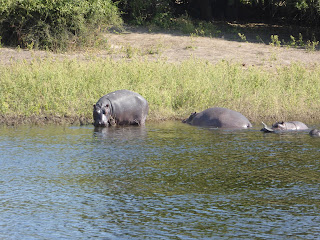As Kim, our city guide for the day, drove us to Soweto she gave us some information about Johannesburg such as it is a land locked city, it is 35 miles from the South African capitol, Pretoria, and has an unemployment rate of 35%.
The country is divided into 9 provences. Joburg is in the smallest provence of Gauteng with the largest population of about 8 million and the township of Soweto (from SOuth WEst TOwnship) covers about 77 square kilometers in the provence (Sedalia is about 35 sq. km). Soweto has about 5 million people and is 98% black. It was created when Apartheid rule was established and all the black people were forced out of the white parts of Joburg or when Joburg wanted their land for the white people. Most of the political leaders of Apartheid, like Mandela and Desmond Tutu, lived in Soweto. There three classes of people living here - well tobdo, middle class and the very poor.
Kim took us thru all parts of the township. There are some very nice homes here made of brick with walled gardens or lawns and are in the 500,000 to 1 million Rand range. You must earn 15,000 rand a month to live here. This area was called Beverly Hills!
The middle class live mostly in apartments or very small homes. If you are elderly and have an income less than 3000 Rand a month then you get free housing. The mining companies used to provide one room hostels for the miners but now whole families of 15-20 people are living in them. They were promised homes built by the government, but so many people showed up to get in line for theses homes that they were over populated before they were even built. The homes the government built were two bedroom, kitchen, and lounge - no bathroom. They were not free as they paid rent. Then Mandela gave them to the people and they added corregated shacks to rent to family or friends. They have no running water, no electricity, no sanitation. Porta potties serve 20-30 families and are only emptied twice a week. Kim told this to us from her experience of coming to the city from a rural village and living in the ‘tin can’ for 4 years. She felt lucky to have this "tin" home as it was better than in her village. This is not shanty town.
Hospitals and clinics and medicines are free. Education is free except that they have to buy uniforms, books and paper so many still cannot afford to send their children to school. Still in Soweto, we stopped at Freedom Square where the Freedom Charter, adopted in 1955, has been set in stone. This is like our Declaration of Independence. Freedom Square is next to the outdoor market because political meetings were held in places where large numbers of people naturally gathered like markets, churches, and funerals.
A young man who lives in the shanty town across the tracks from the square gave us a walking tour of his neighborhood and even invited us into his home. Today was wash day. The women got water from a community spigot, boiled the water and washed everything by hand. 24 people lived in a two room shack with 2 rooms attached outside. Leaky roofs and dirt floors, no electricity, and porta potties.
The Regina Mundy Catholic Church was the site of a student uprising on June 16, 1992 when the government said all black children had to learn Afrikaans. Since English was the norm the children decided to protest. In this area alone there were 4,000 students protesting when police open fired on them after a few threw rocks at the police. Even after the children crowded into the church, the police kept shooting inside the building. Including several other schools, over 600 children died that day. This finally brought Apartheid to the world’s attention.
Following a short walk through Nelson Mandela’s home we had lunch then we went to the Apartheid Museum and Nelson Mandel Exhibit. In the hour and half we were there we learned of Mandel’s life history and the history of apartheid from 1906 thru 2018. It is mind boggling the torture and divisions these people endured and yet we felt no animosity from any of them.



















































